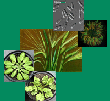| Silva, B; Roos, K; Voss, I; König, N; Rollenbeck, R; Scheibe, R; Beck, E; Bendix, J: Simulating canopy photosynthesis for two competing species of an anthropogenic grassland community in the Andes of southern Ecuador, Ecological Modelling (2012), doi:Doi: 10.1016/j.ecolmodel.2012.01.016. | |
| Abstract: Tropical mountain forest in the Andes of southeastern Ecuador is regularly destroyed to gain pasture land by cultivating the C4 grass Setaria sphacelata. After recurrent burning of the pastures, the grass is partly outcompeted by the C3 southern bracken (Pteridium arachnoideum). This competition represents the problematic of pasture degradation and increasing deforestation, due to the necessity of new pasture land. Because no information on the growth potential of both species in the Andes of Ecuador is available, a growth simulation model has been improved and properly parameterized with field observations. The measured species- and site-specific physiological and edaphic parameters are presented in this paper, as well as the model validation with field observations of leaf CO2 assimilation. The validation showed deviations of simulated from observed leaf net assimilation lower than 5% of the observed values. The validated model was run with a fully realistic meteorological forcing of the year 2008 (10 min time step). The main result points to slightly higher growth potential of Setaria with 5879 g m−2 a−1, based on an annual CO2 net assimilation rate of 217 mol CO2 m−2 a−1. The calculated growth potential of bracken was 5554 g m−2 a−1, based on the CO2 net assimilation of 197 mol CO2 m−2 a−1. In addition, it was shown that decreasing incoming solar radiation and low temperature are favourable weather conditions for bracken in contrary to the pasture grass Setaria. |

